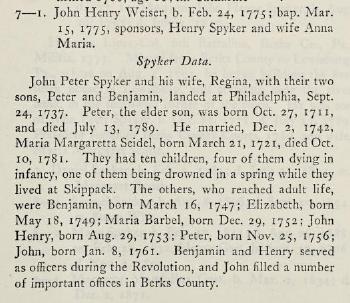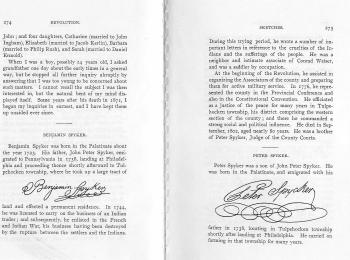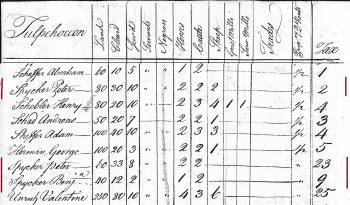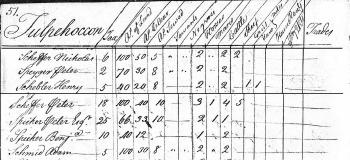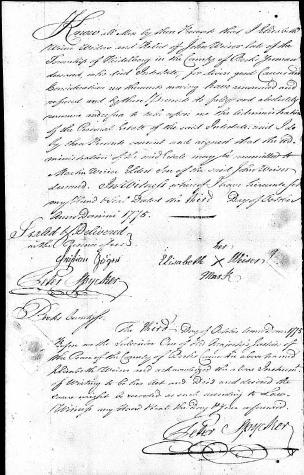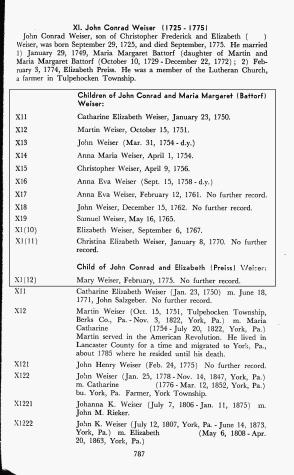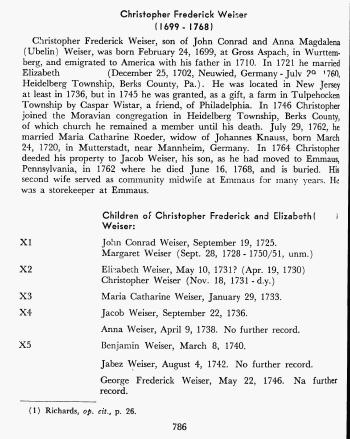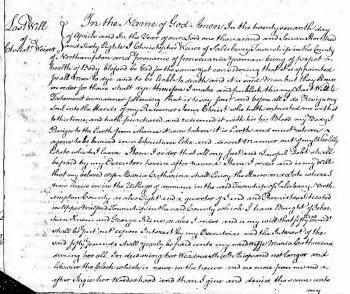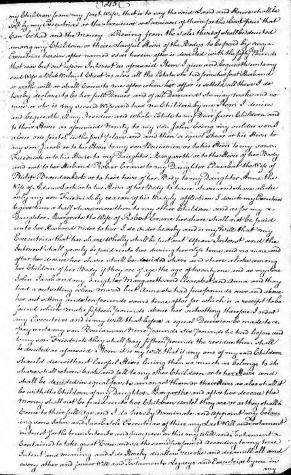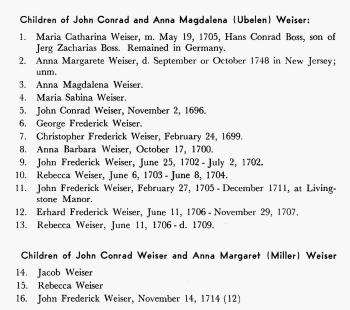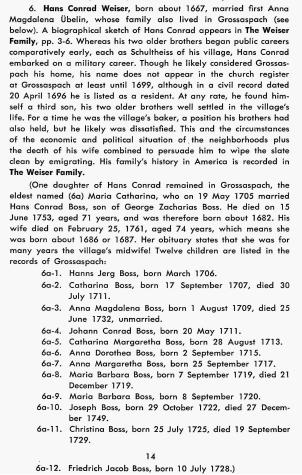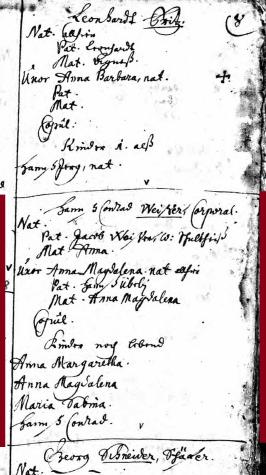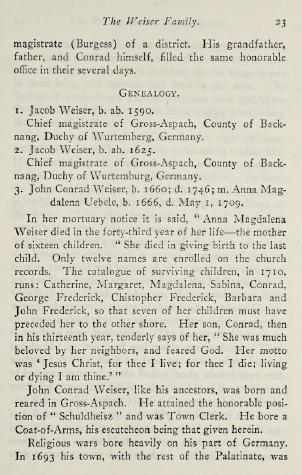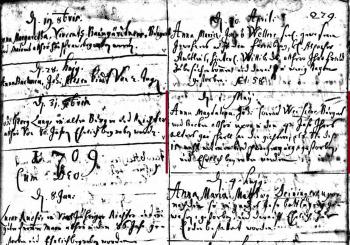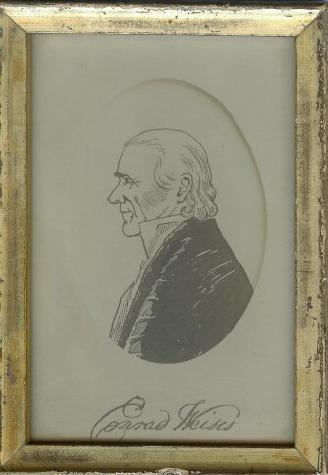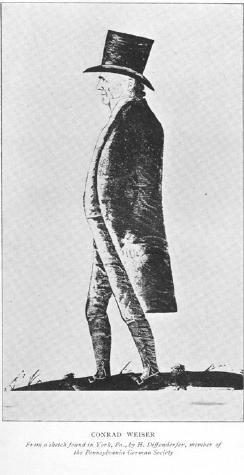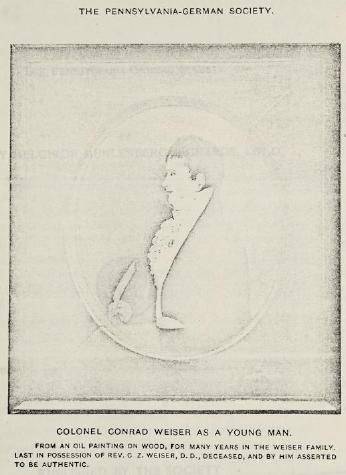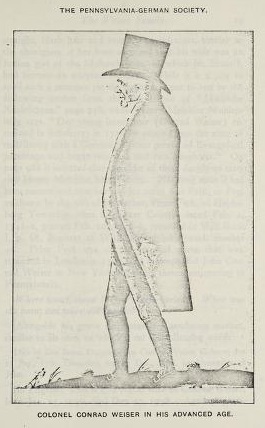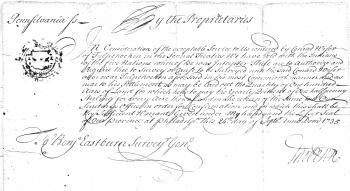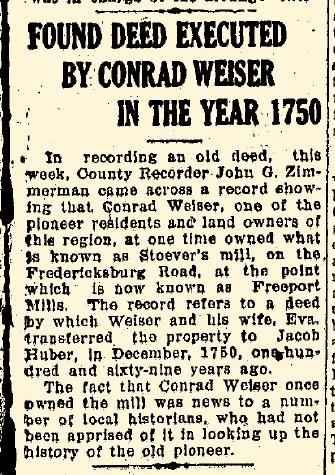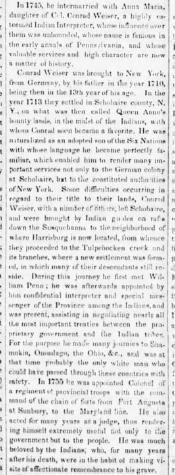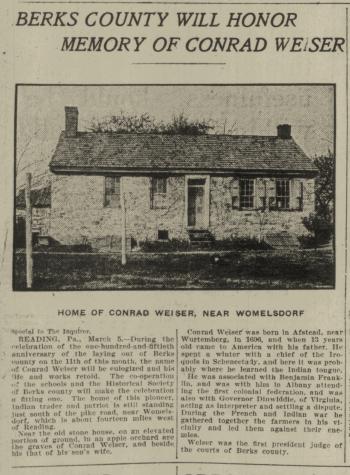Elizabeth Hosterman
F, b. 4 November 1789, d. 4 December 1868
Children of Elizabeth Hosterman and Jonathan Spyker
Catherine Spyker
F
| Father* | Jonathan Spyker b. 12 Mar 1785, d. 29 Dec 1862 |
| Mother* | Elizabeth Hosterman b. 4 Nov 1789, d. 4 Dec 1868 |
Israel Spyker
M
| Father* | Jonathan Spyker b. 12 Mar 1785, d. 29 Dec 1862 |
| Mother* | Elizabeth Hosterman b. 4 Nov 1789, d. 4 Dec 1868 |
Maria Spyker
F
| Father* | Jonathan Spyker b. 12 Mar 1785, d. 29 Dec 1862 |
| Mother* | Elizabeth Hosterman b. 4 Nov 1789, d. 4 Dec 1868 |
Amanda Spyker
F
| Father* | Jonathan Spyker b. 12 Mar 1785, d. 29 Dec 1862 |
| Mother* | Elizabeth Hosterman b. 4 Nov 1789, d. 4 Dec 1868 |
Elizabeth Spyker
F
| Father* | Jonathan Spyker b. 12 Mar 1785, d. 29 Dec 1862 |
| Mother* | Elizabeth Hosterman b. 4 Nov 1789, d. 4 Dec 1868 |
Franklin Spyker
M
| Father* | Jonathan Spyker b. 12 Mar 1785, d. 29 Dec 1862 |
| Mother* | Elizabeth Hosterman b. 4 Nov 1789, d. 4 Dec 1868 |
Lady Ann Spyker
F
| Father* | Jonathan Spyker b. 12 Mar 1785, d. 29 Dec 1862 |
| Mother* | Elizabeth Hosterman b. 4 Nov 1789, d. 4 Dec 1868 |
Maria Margaret Spyker
F, b. 5 July 1786, d. 18 March 1863
| Father* | Colonel John Henry Spyker b. 29 Aug 1753, d. 1 Jul 1817 |
| Mother* | Anna Maria Weiser b. 1 Apr 1754, d. 11 Oct 1829 |
Child of Maria Margaret Spyker and Alexander Graham
- Henrietta Graham b. 1812, d. 9 May 1872
Alexander Graham
M, b. circa 1785, d. 23 August 1839
Child of Alexander Graham and Maria Margaret Spyker
- Henrietta Graham b. 1812, d. 9 May 1872
Eva Elizabeth Spyker
F, b. 31 October 1788, d. 16 March 1790
| Father* | Colonel John Henry Spyker b. 29 Aug 1753, d. 1 Jul 1817 |
| Mother* | Anna Maria Weiser b. 1 Apr 1754, d. 11 Oct 1829 |
Reverand Simon Dreisbach
M, b. 4 March 1802, d. 12 March 1867
| Father* | Martin Dreisbach b. 22 Mar 1776, d. 25 Sep 1850 |
| Mother* | Lydia Spyker b. 30 Jun 1777, d. 12 Jun 1811 |
Children of Reverand Simon Dreisbach and Frances Bowman
- Regina Dreisbach b. 20 Jun 1830
- John Martin Dreisbach b. 29 Nov 1832, d. 19 Sep 1895
- Henry Spyker Dreisbach b. 8 May 1835
- Mary Elizabeth Dreisbach b. 27 Jul 1838
- William Otterbine Dreisbach b. 24 Jul 1842
- Lydia Ann Dreisbach b. 1 Jun 1845
- Thomas Ephriam Dreisbach b. 21 Nov 1850
Citations
- [S249] U.S. Federal Census 1850 U.S. Federal Census, by Ancestry.com, Stamp 395. Dwelling 129.
Frances Bowman
F, b. 30 December 1809, d. 25 June 1895
| Father* | John Bowman |
| Mother* | Catherine Wolff |
Children of Frances Bowman and Reverand Simon Dreisbach
- Regina Dreisbach b. 20 Jun 1830
- John Martin Dreisbach b. 29 Nov 1832, d. 19 Sep 1895
- Henry Spyker Dreisbach b. 8 May 1835
- Mary Elizabeth Dreisbach b. 27 Jul 1838
- William Otterbine Dreisbach b. 24 Jul 1842
- Lydia Ann Dreisbach b. 1 Jun 1845
- Thomas Ephriam Dreisbach b. 21 Nov 1850
Citations
- [S249] U.S. Federal Census 1850 U.S. Federal Census, by Ancestry.com, Stamp 395. Dwelling 129.
John Bowman
M
Child of John Bowman and Catherine Wolff
- Frances Bowman+ b. 30 Dec 1809, d. 25 Jun 1895
Catherine Wolff
F
Child of Catherine Wolff and John Bowman
- Frances Bowman+ b. 30 Dec 1809, d. 25 Jun 1895
Johannes Peter Spyker
M, b. circa 1685, d. February 1762
Children of Johannes Peter Spyker and unknown (?)
- Peter Spyker+ b. 27 Oct 1711, d. 13 Jul 1789
- John Benjamin Spyker+ b. 30 Sep 1723, d. 31 Aug 1802
Children of Johannes Peter Spyker and Regina (?)
- Margaret Barbara Spyker b. 13 Jul 1749
- Peter Spyker+ b. 20 Feb 1752
unknown (?)
F, b. circa 1685
Children of unknown (?) and Johannes Peter Spyker
- Peter Spyker+ b. 27 Oct 1711, d. 13 Jul 1789
- John Benjamin Spyker+ b. 30 Sep 1723, d. 31 Aug 1802
John Benjamin Spyker
M, b. 30 September 1723, d. 31 August 1802
| Father* | Johannes Peter Spyker b. c 1685, d. Feb 1762 |
| Mother* | unknown (?) b. c 1685 |
Child of John Benjamin Spyker and Margaretha Barbara Yeiser
- Henry Spyker d. c 1813
Citations
- [S345] Pennsylvania, History of Berks County in the Revolution 1774-83, page 274-275.
Margaretha Barbara Yeiser
F, b. 18 June 1715, d. 2 July 1806
Child of Margaretha Barbara Yeiser and John Benjamin Spyker
- Henry Spyker d. c 1813
Regina (?)
F, b. circa 1695
Children of Regina (?) and Johannes Peter Spyker
- Margaret Barbara Spyker b. 13 Jul 1749
- Peter Spyker+ b. 20 Feb 1752
Margaret Barbara Spyker
F, b. 13 July 1749
| Father* | Johannes Peter Spyker b. c 1685, d. Feb 1762 |
| Mother* | Regina (?) b. c 1695 |
Peter Spyker
M, b. 20 February 1752
| Father* | Johannes Peter Spyker b. c 1685, d. Feb 1762 |
| Mother* | Regina (?) b. c 1695 |
Children of Peter Spyker and Anna Maria Buhler
- Johannes Spyker b. 1775
- Johan Jacob Spyker b. 1780
- Johanna Regina Spyker b. 1782
Anna Maria Buhler
F, b. circa 1752
Children of Anna Maria Buhler and Peter Spyker
- Johannes Spyker b. 1775
- Johan Jacob Spyker b. 1780
- Johanna Regina Spyker b. 1782
Johanna Regina Spyker
F, b. 1782
| Father* | Peter Spyker b. 20 Feb 1752 |
| Mother* | Anna Maria Buhler b. c 1752 |
John Conrad Weiser
M, b. 29 September 1725, d. September 1775
| Father* | Christopher Frederick Weiser b. 24 Feb 1699, d. 6 Jun 1768 |
| Mother* | Elizabeth Breidenbach b. 25 Dec 1702, d. 29 Jul 1760 |
Children of John Conrad Weiser and Maria Margaret Batdorf
- Catharina Elisabeth Weiser b. 23 Jan 1750, d. 5 Aug 1825
- Martin Weiser b. 15 Oct 1751, d. 3 Nov 1822
- Anna Maria Weiser+ b. 1 Apr 1754, d. 11 Oct 1829
- John Weiser b. 1 Apr 1754
- Christopher Weiser b. 9 Apr 1756, d. 30 Mar 1818
- Anna Eva Weiser b. 15 Sep 1758, d. b 1761
- Anna Eva Weiser b. 12 Feb 1761
- John Conrad Weiser Jr.+ b. 15 Dec 1762, d. 1842
- Samuel Weiser b. 16 May 1765, d. 15 Jan 1838
- Elizabeth Weiser+ b. 6 Sep 1767, d. 10 Feb 1826
- Christina Elizabeth Weiser b. 8 Jan 1770
Child of John Conrad Weiser and Elizabeth Preiss
- Mary Weiser b. Feb 1775
Christopher Frederick Weiser
M, b. 24 February 1699, d. 6 June 1768
| Father* | Corporal John Conrad Weiser b. 1662, d. 13 Jul 1746 |
| Mother* | Anna Magdalena Uebele b. 1668, d. Apr 1709 |
Children of Christopher Frederick Weiser and Elizabeth Breidenbach
- John Conrad Weiser+ b. 29 Sep 1725, d. Sep 1775
- Margaret Weiser b. 28 Sep 1728
- Elizabeth Weiser+ b. 10 May 1731, d. 11 May 1789
- Christopher Weiser b. 18 Nov 1731, d. 1754
- Maria Catherine Weiser b. 29 Jan 1733, d. 1789
- Jacob Weiser+ b. 22 Sep 1736, d. 1 Jan 1808
- Anna Weiser b. 9 Apr 1738
- Benjamin Weiser+ b. 8 Mar 1740, d. 24 Nov 1782
- Jabez Weiser b. 4 Aug 1742, d. b 1768
- George Frederick Weiser b. 22 May 1746
- Margaret Weiser b. 1749, d. 1751
Citations
- [S415] Lutheran Church, Württemberg, Germany Lutheran Church Records 1500-1985, Grab u Großaspach Familienbuch, Taufen, Heiraten, Tote u Pfarrliste 1598-1975. Page 13.
Corporal John Conrad Weiser
M, b. 1662, d. 13 July 1746
| Father* | Jacob II Weiser b. 1625, d. 1694 |
| Mother* | Anna Tretz b. 1628, d. 7 Apr 1696 |
Children of Corporal John Conrad Weiser and Anna Magdalena Uebele
- Maria Catharina Weiser b. 1686, d. 26 Feb 1761
- Anna Margarete Weiser b. 1689, d. Sep 1748
- Anna Magdalena Weiser b. 1692
- Maria Sabina Weiser b. 7 May 1694
- Colonel John Conrad Weiser+ b. 2 Nov 1696, d. 13 Jul 1760
- George Frederick Weiser+ b. 1697, d. 1764
- Christopher Frederick Weiser+ b. 24 Feb 1699, d. 6 Jun 1768
- Anna Barbara Weiser+ b. 17 Oct 1700, d. 1748
- Rebecca Weiser b. 6 Jun 1703, d. 8 Jun 1704
- Johann Friedrich Weiser b. 25 Jun 1703, d. 2 Jul 1703
- John Frederick Weiser b. 27 Feb 1705, d. Dec 1711
- Erhard Frederick Weiser b. 11 Jun 1706, d. 29 Nov 1707
- Rebecca Weiser b. 11 Jun 1706, d. 1709
Children of Corporal John Conrad Weiser and Anna Margaret Miller
- Jacob Weiser b. bt 1711 - 1713
- Rebecca Weiser b. bt 1711 - 1713
- John Frederick Weiser b. 14 Nov 1714, d. 2 Sep 1769
Citations
- [S415] Lutheran Church, Württemberg, Germany Lutheran Church Records 1500-1985, Großheppach Taufen, Heiraten u Tote 1558-1808. Page 493.
- [S415] Lutheran Church, Württemberg, Germany Lutheran Church Records 1500-1985, Grab u Großaspach Familienbuch, Taufen, Heiraten, Tote u Pfarrliste 1598-1975. Page 13.
- [S415] Lutheran Church, Württemberg, Germany Lutheran Church Records 1500-1985, Grab u Großaspach Familienbuch, Taufen, Heiraten, Tote u Pfarrliste 1598-1975. Page 14.
- [S415] Lutheran Church, Württemberg, Germany Lutheran Church Records 1500-1985, Grab u Großaspach Familienbuch, Taufen, Heiraten, Tote u Pfarrliste 1598-1975. Page 17.
- [S415] Lutheran Church, Württemberg, Germany Lutheran Church Records 1500-1985, Grab u Großaspach Familienbuch, Taufen, Heiraten, Tote u Pfarrliste 1598-1975. Page 19.
Anna Magdalena Uebele
F, b. 1668, d. April 1709
| Father* | Hans Johannas Uebele b. 1640, d. Dec 1693 |
| Mother* | Anna Catherine (?) b. 1644 |
Children of Anna Magdalena Uebele and Corporal John Conrad Weiser
- Maria Catharina Weiser b. 1686, d. 26 Feb 1761
- Anna Margarete Weiser b. 1689, d. Sep 1748
- Anna Magdalena Weiser b. 1692
- Maria Sabina Weiser b. 7 May 1694
- Colonel John Conrad Weiser+ b. 2 Nov 1696, d. 13 Jul 1760
- George Frederick Weiser+ b. 1697, d. 1764
- Christopher Frederick Weiser+ b. 24 Feb 1699, d. 6 Jun 1768
- Anna Barbara Weiser+ b. 17 Oct 1700, d. 1748
- Rebecca Weiser b. 6 Jun 1703, d. 8 Jun 1704
- Johann Friedrich Weiser b. 25 Jun 1703, d. 2 Jul 1703
- John Frederick Weiser b. 27 Feb 1705, d. Dec 1711
- Erhard Frederick Weiser b. 11 Jun 1706, d. 29 Nov 1707
- Rebecca Weiser b. 11 Jun 1706, d. 1709
Citations
- [S415] Lutheran Church, Württemberg, Germany Lutheran Church Records 1500-1985, Grab u Großaspach Familienbuch, Taufen, Heiraten, Tote u Pfarrliste 1598-1975. Page 279.
- [S415] Lutheran Church, Württemberg, Germany Lutheran Church Records 1500-1985, Großheppach Taufen, Heiraten u Tote 1558-1808. Page 493.
- [S415] Lutheran Church, Württemberg, Germany Lutheran Church Records 1500-1985, Grab u Großaspach Familienbuch, Taufen, Heiraten, Tote u Pfarrliste 1598-1975. Page 13.
- [S415] Lutheran Church, Württemberg, Germany Lutheran Church Records 1500-1985, Grab u Großaspach Familienbuch, Taufen, Heiraten, Tote u Pfarrliste 1598-1975. Page 14.
- [S415] Lutheran Church, Württemberg, Germany Lutheran Church Records 1500-1985, Grab u Großaspach Familienbuch, Taufen, Heiraten, Tote u Pfarrliste 1598-1975. Page 17.
- [S415] Lutheran Church, Württemberg, Germany Lutheran Church Records 1500-1985, Grab u Großaspach Familienbuch, Taufen, Heiraten, Tote u Pfarrliste 1598-1975. Page 19.
Colonel John Conrad Weiser
M, b. 2 November 1696, d. 13 July 1760
| Father* | Corporal John Conrad Weiser b. 1662, d. 13 Jul 1746 |
| Mother* | Anna Magdalena Uebele b. 1668, d. Apr 1709 |
Children of Colonel John Conrad Weiser and Anna Eva Feck
- Phillip Weiser+ b. 7 Sep 1722, d. 27 Mar 1761
- Anna Madlina Weiser b. 13 Jan 1725, d. 16 Mar 1742
- Anna Maria Weiser+ b. 24 Jun 1727, d. 23 Aug 1802
- Frederick Weiser+ b. 24 Dec 1728, d. 1790
- Peter Weiser b. 27 Feb 1730, d. a 1760
- Christopher Weiser b. 15 Feb 1731, d. b 1760
- Jacob Weiser b. 15 Feb 1731, d. May 1731
- Elizabeth Weiser b. 19 Jun 1732, d. 1736
- Margaret Weiser b. 28 Jan 1734, d. a 1760
- Samuel Weiser b. 23 Apr 1735, d. a 1760
- Benjamin Weiser b. 18 Jul 1736, d. Oct 1736
- Jabez Weiser b. 11 Aug 1740, d. 28 Aug 1740
- Hannah Weiser b. 27 Feb 1742, d. 11 Aug 1742
- Benjamin Weiser b. 12 Aug 1744, d. a 1760
Maria Margaret Batdorf
F, b. 10 October 1729, d. 22 December 1772
| Father* | Johannes Martin Batdorf b. Sep 1698, d. 20 Feb 1782 |
| Mother* | Margaretha Elisabetha Walborn b. 25 Oct 1696, d. 1796 |
Children of Maria Margaret Batdorf and John Conrad Weiser
- Catharina Elisabeth Weiser b. 23 Jan 1750, d. 5 Aug 1825
- Martin Weiser b. 15 Oct 1751, d. 3 Nov 1822
- Anna Maria Weiser+ b. 1 Apr 1754, d. 11 Oct 1829
- John Weiser b. 1 Apr 1754
- Christopher Weiser b. 9 Apr 1756, d. 30 Mar 1818
- Anna Eva Weiser b. 15 Sep 1758, d. b 1761
- Anna Eva Weiser b. 12 Feb 1761
- John Conrad Weiser Jr.+ b. 15 Dec 1762, d. 1842
- Samuel Weiser b. 16 May 1765, d. 15 Jan 1838
- Elizabeth Weiser+ b. 6 Sep 1767, d. 10 Feb 1826
- Christina Elizabeth Weiser b. 8 Jan 1770
Elizabeth Breidenbach
F, b. 25 December 1702, d. 29 July 1760
Children of Elizabeth Breidenbach and Christopher Frederick Weiser
- John Conrad Weiser+ b. 29 Sep 1725, d. Sep 1775
- Margaret Weiser b. 28 Sep 1728
- Elizabeth Weiser+ b. 10 May 1731, d. 11 May 1789
- Christopher Weiser b. 18 Nov 1731, d. 1754
- Maria Catherine Weiser b. 29 Jan 1733, d. 1789
- Jacob Weiser+ b. 22 Sep 1736, d. 1 Jan 1808
- Anna Weiser b. 9 Apr 1738
- Benjamin Weiser+ b. 8 Mar 1740, d. 24 Nov 1782
- Jabez Weiser b. 4 Aug 1742, d. b 1768
- George Frederick Weiser b. 22 May 1746
- Margaret Weiser b. 1749, d. 1751
Anna Eva Feck
F, b. 25 January 1700, d. 11 June 1781
| Father* | Johann Peter Feg b. 17 Nov 1672, d. 5 Dec 1744 |
| Mother* | Anna Maria Risch b. 15 May 1681 |
Children of Anna Eva Feck and Colonel John Conrad Weiser
- Phillip Weiser+ b. 7 Sep 1722, d. 27 Mar 1761
- Anna Madlina Weiser b. 13 Jan 1725, d. 16 Mar 1742
- Anna Maria Weiser+ b. 24 Jun 1727, d. 23 Aug 1802
- Frederick Weiser+ b. 24 Dec 1728, d. 1790
- Peter Weiser b. 27 Feb 1730, d. a 1760
- Christopher Weiser b. 15 Feb 1731, d. b 1760
- Jacob Weiser b. 15 Feb 1731, d. May 1731
- Elizabeth Weiser b. 19 Jun 1732, d. 1736
- Margaret Weiser b. 28 Jan 1734, d. a 1760
- Samuel Weiser b. 23 Apr 1735, d. a 1760
- Benjamin Weiser b. 18 Jul 1736, d. Oct 1736
- Jabez Weiser b. 11 Aug 1740, d. 28 Aug 1740
- Hannah Weiser b. 27 Feb 1742, d. 11 Aug 1742
- Benjamin Weiser b. 12 Aug 1744, d. a 1760
Anna Maria Weiser
F, b. 24 June 1727, d. 23 August 1802
| Father* | Colonel John Conrad Weiser b. 2 Nov 1696, d. 13 Jul 1760 |
| Mother* | Anna Eva Feck b. 25 Jan 1700, d. 11 Jun 1781 |
Child of Anna Maria Weiser and Reverand Henry Melchior Muhlenberg
- Maria Salome Muhlenberg b. 1766, d. 1827
Reverand Henry Melchior Muhlenberg
M, b. 6 September 1711, d. 7 October 1787
| Father* | Nicholas M. Muhlenberg |
Child of Reverand Henry Melchior Muhlenberg and Anna Maria Weiser
- Maria Salome Muhlenberg b. 1766, d. 1827
Maria Salome Muhlenberg
F, b. 1766, d. 1827
| Father* | Reverand Henry Melchior Muhlenberg b. 6 Sep 1711, d. 7 Oct 1787 |
| Mother* | Anna Maria Weiser b. 24 Jun 1727, d. 23 Aug 1802 |
Sarah Spyker
F, b. 15 September 1800
| Father* | John Spyker b. 8 Jan 1761 |
| Mother* | Anna Elizabeth Seidel b. c 1761 |
Martin Wenger
M, b. 23 December 1780, d. 23 November 1860
Child of Martin Wenger and Maria Elizabeth Light
- Mary Wenger+ b. 12 Oct 1802, d. 27 Mar 1885
Maria Elizabeth Light
F
Child of Maria Elizabeth Light and Martin Wenger
- Mary Wenger+ b. 12 Oct 1802, d. 27 Mar 1885
Miron B. Spyker
M, b. February 1858, d. 7 September 1910
| Father* | Peter Spyker b. 3 Dec 1831, d. 14 Jan 1863 |
| Mother* | Margaret T. Hopkins b. 3 Sep 1836, d. 27 Mar 1921 |
Citations
- [S248] U.S. Federal Census 1860 U.S. Federal Census, by Ancestry.com, Stamp 261. Dwelling 59.
- [S246] U.S. Federal Census 1880 U.S. Federal Census, by Ancestry.com, Page 17. ED186. Dwelling 150.
- [S245] U.S. Federal Census 1900 U.S. Federal Census, by Ancestry.com, Year: 1900; Census Place: Conewango, Warren, Pennsylvania; Roll: 1492; Page: 8B; Enumeration District: 0132; FHL microfilm: 1241492.
Kennedy Perry Allshouse
M, b. 14 March 1861
| Father* | Henry Allshouse b. 1 Apr 1837, d. 15 Dec 1932 |
| Mother* | Catharine Spyker b. 21 Oct 1840, d. 5 May 1924 |
Citations
- [S246] U.S. Federal Census 1880 U.S. Federal Census, by Ancestry.com, Page 58. ED198. Dwelling 231.
Clarence E. Allshouse
M, b. circa 1865
| Father* | Henry Allshouse b. 1 Apr 1837, d. 15 Dec 1932 |
| Mother* | Catharine Spyker b. 21 Oct 1840, d. 5 May 1924 |
Citations
- [S246] U.S. Federal Census 1880 U.S. Federal Census, by Ancestry.com, Page 58. ED198. Dwelling 231.
Amy F. Allshouse
F, b. May 1872
| Father* | Henry Allshouse b. 1 Apr 1837, d. 15 Dec 1932 |
| Mother* | Catharine Spyker b. 21 Oct 1840, d. 5 May 1924 |
Citations
- [S246] U.S. Federal Census 1880 U.S. Federal Census, by Ancestry.com, Page 58. ED198. Dwelling 231.
John B. Speaker
M, b. November 1853, d. 1919
| Father* | Abner Spyker b. 16 Nov 1829, d. 1 Jun 1896 |
| Mother* | Catherine A. Gearhart b. 25 Aug 1831, d. 11 Aug 1912 |
Children of John B. Speaker and Nancy Ann Dobson
- Wayne Arthur Speaker+ b. 23 May 1877
- Mayme June Speaker+ b. Aug 1883, d. 5 Mar 1931
- John Burton Speaker+ b. 24 Jan 1888, d. Jan 1960
- Abner Joel Speaker b. 30 Sep 1890, d. 30 May 1971
- Jay Cook Speaker b. 11 Dec 1892, d. 21 May 1973
Citations
Nancy Ann Dobson
F, b. March 1854, d. 1943
Children of Nancy Ann Dobson and John B. Speaker
- Wayne Arthur Speaker+ b. 23 May 1877
- Mayme June Speaker+ b. Aug 1883, d. 5 Mar 1931
- John Burton Speaker+ b. 24 Jan 1888, d. Jan 1960
- Abner Joel Speaker b. 30 Sep 1890, d. 30 May 1971
- Jay Cook Speaker b. 11 Dec 1892, d. 21 May 1973
Citations
- [S246] U.S. Federal Census 1880 U.S. Federal Census, by Ancestry.com, Page 58. ED198. Dwelling 229.
- [S245] U.S. Federal Census 1900 U.S. Federal Census, by Ancestry.com, ED78. Dwelling 230.
- [S243] U.S. Federal Census 1920 U.S. Federal Census, by Ancestry.com, Year: 1920; Census Place: Rose, Jefferson, Pennsylvania; Roll: T625_1575; Page: 3B; Enumeration District: 168; Image: 968.

